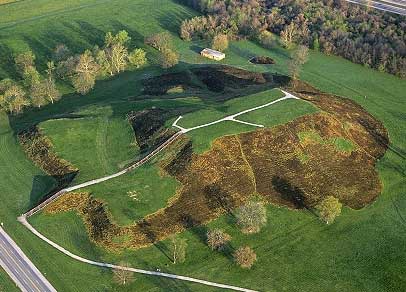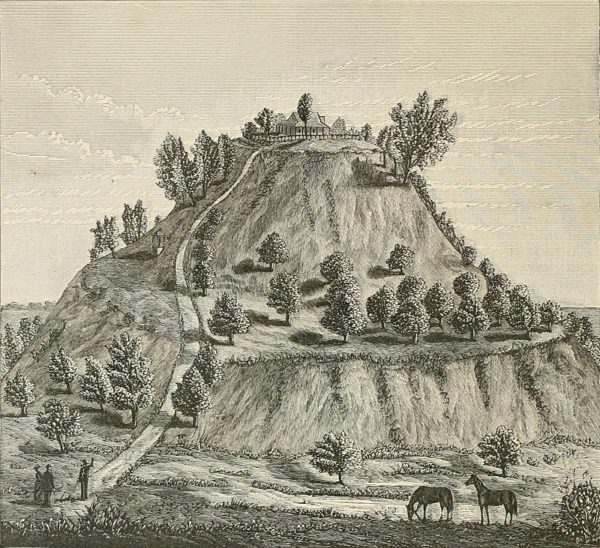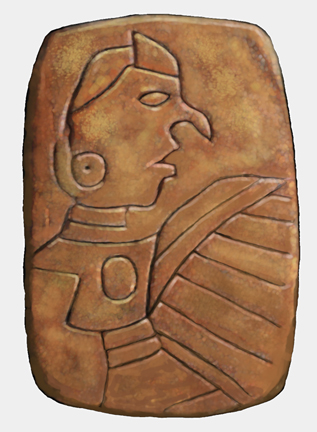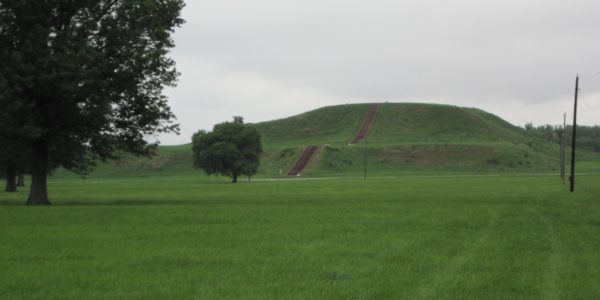 I recently learned that there once was an urban complex of Native Americans in the United States that dates back to the 9th century. I had heard of the Mayans, was somewhat familiar with the Aztec civilization that built pyramids in Mexico, and had even visited Teotihuacan when I was in high school. Over the years, I have visited Anasazi ruins and other Native American sites in the southwest U.S. And of course I learned about the decimation of the native tribes across the continent, due to diseases like smallpox, brought by the explorers and settlers. I am aware of the egregious nineteenth century westward relocation of the Indians in the U.S. However, I did not really know much about the land and the indigenous people who lived here before European contact. What was wrong with my American history education and my personal blindspots that I was never taught or somehow missed, glossed over, or forgot about this important pre-colonial history? In any case, I found it very interesting to learn that North American indigenous people established a city center in present-day southern Illinois, close to the St. Louis area, that came to be known as Cahokia, which means “Wild Geese.”
I recently learned that there once was an urban complex of Native Americans in the United States that dates back to the 9th century. I had heard of the Mayans, was somewhat familiar with the Aztec civilization that built pyramids in Mexico, and had even visited Teotihuacan when I was in high school. Over the years, I have visited Anasazi ruins and other Native American sites in the southwest U.S. And of course I learned about the decimation of the native tribes across the continent, due to diseases like smallpox, brought by the explorers and settlers. I am aware of the egregious nineteenth century westward relocation of the Indians in the U.S. However, I did not really know much about the land and the indigenous people who lived here before European contact. What was wrong with my American history education and my personal blindspots that I was never taught or somehow missed, glossed over, or forgot about this important pre-colonial history? In any case, I found it very interesting to learn that North American indigenous people established a city center in present-day southern Illinois, close to the St. Louis area, that came to be known as Cahokia, which means “Wild Geese.”
 Enabled by the adoption of agrarian communities, located outside the city in satellite villages, Cahokia grew to encompass an area of approximately 6 square miles, with up to 120 earthen mounds. The population at the most developed time (1100-1250 ce.) has been estimated at around 20,000 people, more than that of London, England at the time. It served as a cultural and trade center for the inhabitants, who developed a widespread and intricate trading system that stretched from the Great Lakes, south to the Gulf of Mexico. It was part of a larger community known as the Mississippian Culture and has been described as the “most sophisticated prehistoric native civilization north of Mexico.”
Enabled by the adoption of agrarian communities, located outside the city in satellite villages, Cahokia grew to encompass an area of approximately 6 square miles, with up to 120 earthen mounds. The population at the most developed time (1100-1250 ce.) has been estimated at around 20,000 people, more than that of London, England at the time. It served as a cultural and trade center for the inhabitants, who developed a widespread and intricate trading system that stretched from the Great Lakes, south to the Gulf of Mexico. It was part of a larger community known as the Mississippian Culture and has been described as the “most sophisticated prehistoric native civilization north of Mexico.”
Researchers have located 109 mounds in the area, each built as a platform, ridge-top, or conical structure and each with its own function and meaning. Some of the mounds were used as burial sites. The largest mound (Monks Mound) is over one hundred feet high and “stood tall in the prairies” as the highest structure in North America until 1867. Its base is about the same size as the Great Pyramid at Giza, and it is estimated that it took around 20 years to build. Monks Mound is now a UNESCO World Heritage Site, situated at the Cahokia Mound State Historic Site in southern Illinois. This large platform mound has four terraces and was constructed in at least ten separate phases. It was aligned with the four cardinal directions and may have been symbolically connected to their underworld lunar maize goddess. Excavation of Monks Mound and its subsequent analysis/research revealed evidence of a large building at the top of the site. This edifice, visible throughout the surrounding area, was probably the dwelling of the chief or a temple that may have been a pilgrimage destination.
 Because the Mississippian people did not produce written records, most of the information we have, regarding the lifestyles of the indigenous peoples of this period, comes from artifacts, symbols and tribal oral traditions. For example, one prevalent Mississippian Culture motif found in stone and copper artifacts, is the birdman. The stone tablet shown here was found at Monk’s Mound in 1971, and excavation near Mound 34 uncovered evidence of a copper workshop – so far the only one located in a Mississippian site. The birdman maintained a central position in Cahokian iconography, and copper birdman artifacts that were likely made at Cahokia have been found as far away as present day Florida and Oklahoma.
Because the Mississippian people did not produce written records, most of the information we have, regarding the lifestyles of the indigenous peoples of this period, comes from artifacts, symbols and tribal oral traditions. For example, one prevalent Mississippian Culture motif found in stone and copper artifacts, is the birdman. The stone tablet shown here was found at Monk’s Mound in 1971, and excavation near Mound 34 uncovered evidence of a copper workshop – so far the only one located in a Mississippian site. The birdman maintained a central position in Cahokian iconography, and copper birdman artifacts that were likely made at Cahokia have been found as far away as present day Florida and Oklahoma.
 Beginning near the late 13th century, the Cahokia community began to decline and disperse. It’s not entirely clear what happened, but it is possible that there were environmental factors that endangered the city. Such causes for decline may have included overhunting, deforestation, and climate change events, such as flooding or drought. Perhaps failed crops on the outskirts of Cahokia resulted in food insecurity, an unsustainable condition within the city itself. In addition, economic and political issues may have influenced the situation. Some scholars have proposed that conquest-induced political collapse might have been the primary cause for desertion. Whatever the combination of contributing factors, by the end of the 14th century, Cahokia was essentially abandoned.
Beginning near the late 13th century, the Cahokia community began to decline and disperse. It’s not entirely clear what happened, but it is possible that there were environmental factors that endangered the city. Such causes for decline may have included overhunting, deforestation, and climate change events, such as flooding or drought. Perhaps failed crops on the outskirts of Cahokia resulted in food insecurity, an unsustainable condition within the city itself. In addition, economic and political issues may have influenced the situation. Some scholars have proposed that conquest-induced political collapse might have been the primary cause for desertion. Whatever the combination of contributing factors, by the end of the 14th century, Cahokia was essentially abandoned.
If you liked this blog post, you may also be interested in the one I wrote about the Karankawa Indians, who lived along the Gulf Coast near Houston and who were entirely exterminated.
Reference 1: Blake de Pastino, Western Digs, http://westerndigs.org/americas-largest-earthwork-cahokias-monks-mound-may-have-been-built-in-only-20-years-study-says/September 2015.
Reference 2: National Endowment for the Humanities, National Humanities Alliance, “Bringing the Ancient Cahokia Mounds to Life,” https://nehforall.org/projects/bringing-the-ancient-cahokia-mounds-to-life.
Reference 3: Michael E. Dickey, The People of the River’s Mouth: In Search of the Missouria Indians, University of Missouri Press, sponsored by The State Historical Society of Missouri, 2011.
Reference 4: HeartLands Conservancy, “The Mounds – America’s First City,” https://heartlandsconservancy.org/communities/the-mounds-americas-first-cities/. HeartLands Conservancy that, among other issues, advocates for establishing Cahokia mounds as a National Historic Site.
Reference 5: https://cahokiamounds.org, Cahokia Mounds website, originally authored by Ken Keller, Eric Young, and Gary Kront, is maintained by the staff of the Cahokia Mounds State Historic Site and Cahokia Mounds Museum Society. A very interesting and informative map of the mounds can be found at https://cahokiamounds.org/cahokia-map/.
Reference 6: https://libguides.jeffco.edu/missouritribes, Indigenous Tribes of Missouri: Missouri’s Native Peoples, website that includes a three-part series in Missouri Life magazine by Ron Soodalter, 2018.
Image 1: Aerial photograph of Monk’s Mound in southern Illinois, Western Digs.
Image 2: Monk’s Mound Illustration from History of Madison County, Illinois published by W. R. Brink & Co., 1882, public domain.
Image 3: Birdman Tablet, photo by Herb Roe in 2012, CC BY-SA 3.0.
Image 4: Monk’s Mound, photographed from the Grand Plaza, Wikimedia Commons.















2 Comments
Leave your reply.